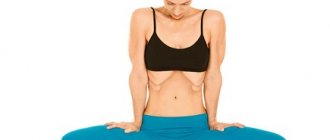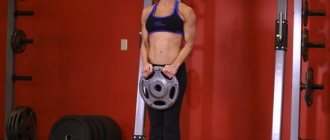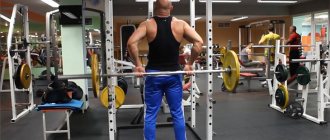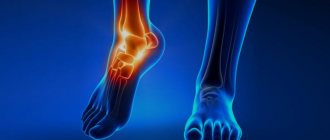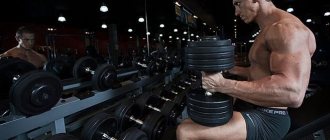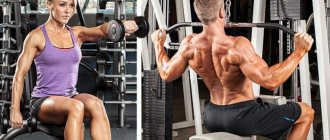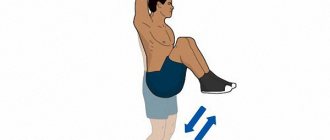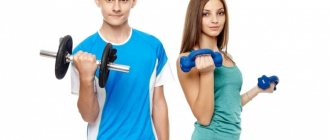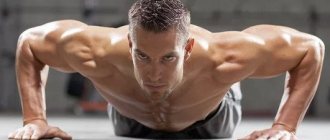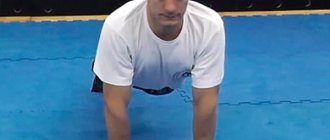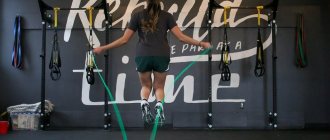Static exercises (isometric)
- these are exercises in which, during execution, the muscles do not contract, that is, the muscle tenses, but there is no movement. From a mechanical standpoint, work is not being done. When performing static exercises, your muscles hold the body or a specific joint in a stationary position. A striking example of a static exercise that was reviewed on our website is. The essence of this exercise is to keep the body motionless for a certain period of time, for example 1 minute. It perfectly works not only your abs, but also many other muscle groups. It’s not for nothing that it was included in the list of the most.
Static exercises should not scare you, because they are as natural as dynamic ones. Dynamic exercises are exercises in which your muscles are contracted (activated) and your body is allowed to move. A striking example is:, etc. Static and dynamic work involves keeping your body motionless (back muscles). When you perform barbell curls, the static work is performed by the deltoids, as well as the back muscles. Examples can be given endlessly, but my task is to convey this material to you in an accessible form so that the meaning itself is clear.
They take on most of the work, or as they are called slow ones, if the work is done at half strength or less. They are called red because they contain more myoglobin compared to white ones; it is myoglobin that gives them a redder tint.
If, however, a static exercise is performed with a large expenditure of energy or even to the maximum, the work begins. If the static tension is high, then the exercise develops strength and increases muscle volume, slightly yielding to the usual dynamics. With increased static load, the capillaries in the muscle fibers are pinched, accordingly the blood flow stops, and oxygen and glucose are no longer supplied to the muscles. All together leads to an increase in the load on the heart and the entire circulatory system, which has a negative impact.
It is impossible not to notice a feature in which muscles that are constantly exposed to static loads noticeably reduce their flexibility.
Of course, one cannot fail to note such a big advantage of static exercises as the fact that they can be performed practically anywhere, in any conditions. They do not require you to carry any additional equipment with you. Of course, if you perform static loads in a well-equipped gym, you can increase the effectiveness of the implementation by adding additional equipment.
Without condition, before each workout you should definitely do a good one.
To develop slow-twitch (red) muscle fibers, the exercise should be performed without the additional use of weights. Sets of exercises with yoga or may be perfect.
How to perform the exercise: you should take the desired body position and remain in this position until a burning sensation begins to appear, after which you need to wait 5-10 seconds and complete the exercise. A single exercise can be performed in several approaches.
As stated in the article, to engage red muscle fibers, the exercise must be performed at half strength or less.
If you want to engage white muscle fibers, you should perform the load with maximum force, using some external means (use additional weight), etc., which will make the exercise more difficult.
After performing sets of static exercises, you should do additional warm-up and stretching. You can also include some breathing exercises.
Conclusions:
Based on all of the above, we can draw the following conclusions and recommendations:
1. If you have problems with the cardiovascular system, heart problems, or any contraindications, you should not perform static exercises with high voltage.
2. Accordingly, in the absence of problems or any contraindications, increased load can be used to increase muscle volume and strength.
3. To effectively burn excess fat tissue, static exercises should be added to the training process (they need to be performed at half strength).
4. If you decide to supplement your workout with static loads, you need to pay special attention to warming up and stretching before performing.
5. Isometric (static) exercises can be performed daily, because after them, you don’t feel particularly tired the next day. Of course, you should also not abuse such loads. Everything should be in moderation.
6. Despite all the positive aspects of static loads, they cannot fully replace dynamic exercises.
7. Static exercises to develop strength should be performed with maximum load.
The next article will list the best static exercises, subscribe so you don't miss it!;)
Not much video motivation for your workouts:
4 shares
Anyone can perform static exercises. Bend your elbow and feel your biceps tighten. Hold for 30 seconds. So you have done your first static exercise in your life.
This type of training has many advantages, including the possibility of high-quality rehabilitation after injuries with its help and maintaining shape. In addition, “statics” may become the only training option for a person who does not want to go to the gym or purchase any equipment. But, like any particular method in physical education, it cannot be the only type of physical activity.
Professional training
How long do famous champions - bodybuilders and athletes - train? Although their preferred exercises differ significantly, the training time is approximately the same. As a rule, “pros” and champions expose themselves to strength training for 2-3 hours 5-6 times a week. With such intensity of exercise with weights, there is a risk of serious muscle dysfunction and general deterioration in health. To prevent this from happening, strength training is regularly combined with walking, swimming, martial arts, etc.
What are the advantages of static exercises
The main benefit is that static contractions can maintain muscle mass during periods of forced inactivity. Static exercises for developing strength are used for:
- active rehabilitation after injuries to joints and ligaments. During the period when the inflammation has stopped and the person returns to training, he can exercise on non-injured parts of the body, using classical exercises and maintain static shape where movements in the joints are excluded;
- “punching” some weak point in complex multi-joint exercises. In this case, a pause is used in the part of the movement from which problems begin. For example, if an athlete begins to “fold” towards the hips in the middle part of the squat amplitude, he should stop at this point and spend 8 to 12 seconds there, and then continue the movement;
- increasing strength indicators when the problem with them is the lack of stability during the exercise. This is a narrow technique used in powerlifting. Here a number of static exercises can be used to fix, for example, the correct position of the upper back in a squat.
In the training of amateurs with statics, outright chaos reigns. Some sources claim that, for example, callanetics, helps to get all the bonuses of strength exercises, including increasing muscle tissue density and accelerating metabolism, but without performing strength exercises. They often tell us that if a person does not want to “pump up muscles”, but strives for the slender figure of a ballerina, static is his everything.
Others point out the obvious benefits of statics for weight loss:
- people with a lot of weight already experience overload in their joints; if you replace regular exercises with weights with static ones, you can avoid pain in the knees and hip joints and reduce the load on the spine;
- those who are embarrassed to go to the gym can train at home and maintain the regularity necessary for losing weight without unnecessary stress;
- statics teaches you to feel muscle work. After a “course” of the same callanetics, learning basic power movements is much easier, and the safety of such practice will be at its best;
- statics allows you to not increase muscle volume too much, which is a plus for those who are afraid of becoming “big” but not slim.
Important: static gymnastics, for example, callanetics, are not a panacea for excess weight. In terms of fat burning (increasing calorie expenditure), they are inferior to even the simplest strength training, so they must be supplemented either with a fairly strict diet or with other types of training. The optimal combination is a cardio load of up to 200 minutes per week and three to four static one-hour workouts in a weekly physical activity plan. Including cardio is also advisable for the reason that static strength exercises do not train the cardiovascular system in any way and do not help increase calorie consumption.
3.1. Methods for developing flexibility
To develop and improve flexibility, it is methodically important to determine the optimal proportions in the use of stretching exercises, as well as the correct dosage of loads. If it is necessary to achieve a noticeable shift within 3-4 months, then the following ratios in the use of exercises are recommended: approximately 40% active, 40% passive and 20% static.
It is important to combine flexibility exercises with strength and relaxation exercises. It has been established that the integrated use of strength and relaxation exercises not only helps to increase the strength and elasticity of the muscles producing this movement, but also increases the strength of the muscular-ligamentous apparatus. In addition, when using relaxation exercises during the period of targeted development of mobility in the joints, the effect of training increases significantly (up to 10%).
When performing flexibility exercises in individual classes and throughout the year, you should increase the load by increasing the number of exercises and the number of their repetitions. The tempo for active exercises is 1 repetition per 1 s; for passive ones - 1 repetition in 1-2 s; “exposure” in static positions - 4-6 s.
It is recommended to perform flexibility exercises in one lesson in the following sequence: first, exercises for the joints of the upper extremities, then for the torso and lower extremities. When performing these exercises serially, relaxation exercises are given during rest periods.
There are different opinions on the number of classes per week aimed at developing flexibility. However, all experts agree that at the initial stage of working on developing flexibility, it is enough to exercise 2-3 times a week.
Flexibility exercises are performed in all parts of the training session. In the preparatory part of the lesson, they are used during warm-up, usually after dynamic exercises, gradually increasing the range of movements and the complexity of the exercises themselves.
In the main part, such exercises are performed in series, alternating with the work of the main focus, or simultaneously with strength exercises. If developing flexibility is one of the main objectives of a training session, then sometimes it is advisable to concentrate stretching exercises in the second half of the main part of the session, highlighting them as an independent “block” of load.
In the final part, stretching exercises are combined with relaxation exercises and self-massage.
At the same time, the effectiveness of the stretching exercises used depends on the focus of the training work performed in this lesson.
Before speed-strength work in the warm-up, it is advisable to include active dynamic stretching exercises, self-massage and shaking of the working parts of the body, as well as perform a series of 1-2 special preparatory stretching exercises during the work itself. This methodological approach is justified when training the start and starting acceleration or maximum speed in a 100 m run. In this case, after warming up, a series of runs from the start and on the run are performed in segments from 10 to 60 m. Before each series of speed exercises, active dynamic exercises are performed on stretching and relaxing the muscles of the legs and pelvis: various bends, swinging the legs, shaking the muscles, etc. A similar methodological technique for using stretching exercises is recommended when performing jumping exercises and in hand-to-hand combat training.
3.1.1. Method of combined development of strength and flexibility .
Particular attention should be paid to stretching muscles and ligaments when performing strength exercises, given their possible negative effect on flexibility. An undesirable decrease in muscle contractility from strength exercises can be overcome by three methodological techniques:
1. Consistent use of strength and flexibility exercises. Here it is possible to use both a direct sequence of using a set of exercises (strength + flexibility) and a reverse sequence (flexibility + strength). In the first case, under the influence of performing a series of strength exercises, mobility in working joints gradually decreases by 20-25%, and after performing a set of stretching exercises, it increases by 50-70% of the reduced level.
The reverse sequence of exercises is more preferable if it is necessary to perform strength exercises with a maximum range of motion, but strength capabilities will noticeably decrease.
2. Alternating use of strength and flexibility exercises (strength + flexibility + strength + ...) during one training session. With this option for constructing a lesson, a step-like change in the mobility of the working parts of the body occurs. After each strength exercise, flexibility decreases, and after stretching, it increases again with a general tendency for it to increase by the end of the session to 30-35% of the initial level.
3. Simultaneous (combined) development of strength and flexibility in the process of performing strength exercises.
In case of severe fatigue after performing large volumes of technical, strength, speed-strength loads, it is recommended to use “passive” dynamic stretching exercises. This is due to the fact that in conditions of severe muscle fatigue such exercises are not only more effective, but also less traumatic. Sets of passive exercises are best used at the end of the main or final parts of the lesson, as well as in the form of a separate “recovery” workout. After a large volume of endurance training, such as a long or tempo cross-country run, high volume of repetition or interval work, it is best to perform 5-6 light active dynamic stretches, being careful not to injure the fatigued muscles.
At the same time, it was noticed that, even after an intensive warm-up using mainly dynamic exercises, despite the increase in muscle temperature and the general increase in the amplitude of movements, the ligaments are not always prepared for the maximum range of speed-strength work. Therefore, sometimes a greater effect is achieved when building a warm-up based on static stretching exercises. This warm-up is recommended when improving hand-to-hand combat techniques.
You just need to always remember that you can stretch only after a good warm-up and you should not have severe pain, but only a feeling of slightly “stretched” muscles and ligaments.
3.1.2. Repeated stretch method
This method is based on the property of muscles to stretch much more with repeated repetitions of the exercise with a gradual increase in the range of movements. The exercises begin with a relatively small range of motion and gradually increase it by 8-12 repetitions to the maximum, or a limit close to it. Highly skilled athletes, for example, manage to continuously perform exercises at or near maximum amplitude up to 40 times. The limit for the optimal number of repetitions of an exercise is the beginning of a decrease in the range of movements or the occurrence of pain that must be avoided. The number of repetitions of exercises varies depending on the nature and focus of the exercise to develop mobility in a particular joint, the tempo of movements, the age and gender of those involved. Active dynamic exercises are usually performed at a higher tempo than all others, and their dosage depends significantly on the joint being worked and the training objectives.
When determining the maximum number of repetitions of exercises on any joint in one training session, you can adhere to the parameters given in Table 3. For teenagers, the number of repetitions is reduced by about 50-60%, and for women - by 10-15%. Passive dynamic exercises with a partner are performed at a slower pace with the same dosage. Dosage of performing flexibility exercises using the method of repeated stretching when solving various training problems (according to B.V. Sermeev, 1970).
Table 3
Maximum Exercise Reps Options
| № | Under development joints | Training Objectives | |
| Development of flexibility | Maintaining flexibility | ||
| 1. | Spinal column | 90-100 | 40-50 |
| 2. | Brachial | 50-60 | ZO-40 |
| 3. | Radiocarpal | 30-35 | 20-25 |
| 4. | Hip | 60-70 | 30-40 |
| 5. | Knee | 20-25 | 20-25 |
| 6. | Ankle | 20-25 | 10-15 |
But the most effective is the use of complexes of several active dynamic stretching exercises, 8-15 repetitions of each of them. During one training session there may be several such series of exercises, performed with little rest or interspersed with exercises of a different focus (usually technical, strength or speed-strength). In this case, it is necessary to ensure that the muscles do not “freeze.”
3.1.3. Static stretch method
This method is based on the dependence of the amount of stretching on its duration. First you need to relax, and then perform the exercise, holding the final position for 10 - 15 seconds to several minutes. Sets of static stretching exercises can also be performed with a partner. Isometric stretching is a type of static stretching in which you add resistance to stretched muscle groups by contracting them isometrically. For example, you put your foot against a wall, trying to move it, knowing that this will not happen. No movement occurs, but the muscle tenses. This type of stretching is more effective for developing passive flexibility and muscle strength. It can be performed with the help of a partner, equipment, your own hands, using a wall, floor, supports.
This type of exercise is not recommended for children and older people because... in the former, the bones are not yet strong enough, and in the latter, they can be very fragile, because the load on the bones, with such stretching, is very high. There are several methods of isometric stretching:
1. take a position as for passive stretching, 7-15 s of isometric effort, 20 s of rest and relaxation.
2. take the position, 7-15 s isometric effort, 2-3 s softening, with the help of a partner, hands or equipment, smoothly bring to a more stretched position for 10-15 s. Then rest for 20 s.
3. take a position, 7-15 s isometric tension of the stretched muscles, 7-15 s isometric tension of the antagonist muscles (muscles performing the opposite action to the first). For example, biceps and triceps are antagonistic muscles. The biceps flexes the arm, the triceps extends it.
It is recommended to do 1 to 5 repetitions for each muscle group. Isometric stretching should not be performed more than once every 24-36 hours. It is best to alternate between static and passive stretching every other day. There are a number of recommendations that should not be neglected when training flexibility. They greatly increase efficiency and reduce the possibility of injury.
If you are faced with the task of increasing flexibility, then stretching exercises must be performed daily. To maintain flexibility at the level already achieved, you can reduce the number of classes to 2-3 per week. At the same time, it is also possible to reduce the volume of stretching exercises performed in each training session. Typically, during the day, a total of 15 to 60 minutes are spent doing stretching.
3.1.4. Stretching
Stretching is a system of exercises that develop flexibility and help increase muscle elasticity. The term stretching comes from the English word stretching - to pull, stretch.
During static stretching exercises, the student takes a certain position and holds it for 15 to 60 seconds, while he can strain the stretched muscles.
The physiological essence of stretching is that when muscles are stretched and held in a certain position, the processes of blood circulation and metabolism are activated in them.
In the practice of physical education and sports, stretching exercises can be used: in a warm-up after warm-up exercises as a means of preparing muscles, tendons and ligaments for a volumetric or high-intensity training program; in the main part of the lesson (lesson) as a means of developing flexibility and increasing the elasticity of muscles and ligaments; in the final part of the lesson as a means of recovery after high loads and prevention of injuries to the musculoskeletal system, as well as relieving pain and preventing seizures.
There are various stretching options. The most common sequence of exercises is the following: muscle contraction phase (strength or speed-strength exercise) lasting 1-5 s, then muscle relaxation for 3-5 s and then stretching in a static position for 15 to 60 s. Another method of stretching is also widely used: dynamic (springy) exercises, performed in the warm-up or the main part of the lesson, end with holding a static pose for a while in the last repetition.
The duration and nature of the rest between exercises are individual, and the pause itself for exercisers can be filled with slow running or active rest.
The stretching technique is quite individual. However, certain training parameters can be recommended:
1. duration of one repetition (holding the pose) from 15 to 60 s;
2. the number of repetitions of one exercise is from 2 to 6 times, with rest between repetitions of 10-30 s;
3. the number of exercises in one complex from 4 to 10;
4. the total duration of the entire load is from 10 to 45 minutes; nature of rest - complete relaxation, jogging, active rest.
3.1.5. Yoga
Of the 84,000 yoga poses, only about 84 basic asanas are performed. A simple visual analysis shows that about 90% of the main asanas are aimed at developing the flexibility of one or another part of the musculoskeletal system.
Compared to other methods of developing flexibility, yoga exercises have a number of advantages. Firstly, yoga exercises are not performed with such great muscle tension; they are devoid of unnecessary damaging effects on body tissue. Yoga exercises actively involve proprioceptors (nerve endings in tendons, ligaments and joint capsules) and interoreceptors (nerve endings of internal organs), which, according to modern medicine, is an important factor in health.
Secondly, the body of yogis is not distinguished by overly developed muscles. Yogis have a slender youthful body without excess fat deposits.
Thirdly, yoga exercises can be performed taking into account their individual capabilities. Yoga poses, when correctly selected and applied, have an effect on all organs and systems of the body, without causing blood outflow from them, but, on the contrary, improving its circulation.
Fourthly, it is known that yogis achieved such physical perfection and the ability to control their body by alternating centuries of thoughtful and practiced body positions (asanas) and complete muscle relaxation. And the ability to relax your muscles is one of the main conditions for developing flexibility.
Biochemical analysis of the main yoga asanas allows us to conclude that there is no joint left in the human body, not even a small piece of muscle that is not stretched. Some of the exercises are aimed at stretching the back surface of the body, others at the front, others at the side surfaces, and there are also exercises that allow you to stretch the muscles when twisting either the spine or individual parts of the body.
3.2. Tools for developing flexibility
Exercises aimed at developing flexibility are based on performing a variety of movements: flexion-extension, bending and turning, rotations and swings. Such exercises can be performed independently or with a partner, with various weights or simple training devices: with cuffs, weights, pads, against a gymnastic wall, as well as with gymnastic sticks, ropes, jump ropes. Sets of such exercises can be aimed at developing mobility in all joints to improve overall flexibility without taking into account the specifics of your motor activity.
When improving special flexibility, sets of special preparatory exercises are used, logically selected for a targeted impact on the joints, mobility in which most determines the success of professional or sports activities. For example, for accelerated movement by running and skiing, flexibility of the spine and mobility in the hip and ankle joints are important. Swimming and throwing projectiles also require high mobility in the shoulder and wrist joints. Mastering effective martial arts and hand-to-hand combat techniques requires high mobility in all joints, but, above all, in the shoulder and hip.
Through the targeted implementation of special sets of exercises, it is possible to achieve much greater flexibility than is required in the process of professional or sports activities. This creates a certain “margin of flexibility”. If you do not have such a reserve and the existing level of mobility in the joints is used “to the limit,” then it is difficult to achieve maximum accuracy, strength, speed and economy of movements, their “ease.”
The exercises performed can be active, passive and mixed, and also performed in dynamic, static or audible static-dynamic mode.
The development of active flexibility is facilitated by independently performed exercises with your own body weight and with external weights. Such exercises include, first of all, various swinging movements, springy repeated movements in the trained joints. The use of small weights allows, through the use of inertia, to briefly overcome the normal limits of mobility in the joints and increase the range of movements.
Performing stretching exercises with relatively heavy weights increases passive flexibility. The most effective for improving passive flexibility are smoothly performed forced movements with a gradual increase in their working amplitude with inferior muscle work. It is not recommended to perform rapid movements due to the fact that the protective reflex of limiting stretching that occurs in the muscles causes “tightening” of the stretched muscles. Passive flexibility develops 1.5-2.0 times faster than active flexibility.
As a means of developing flexibility, exercises that can be performed with maximum amplitude are used. They are otherwise called stretching exercises.
The elongation of muscle fibers can increase under the influence of exercise. At the same time, their ability to return to their original position should not be affected. Therefore, you should keep in mind the methodological instruction - to combine special exercises for developing flexibility with exercises for strength.
Main types of exercises. Stretching exercises include active, passive and static. Active exercises with full amplitude (swings of arms and legs, jerks, bends and circular movements of the body) can be performed without objects and with objects. Passive flexibility exercises involve movements performed with the assistance of a partner, a resistance band, or a shock absorber; movements with weights; passive movements using one's own strength. Static exercises, performed with the help of a partner, your own body weight or force, require maintaining a stationary position with maximum amplitude for a certain time. This is followed by relaxation and then repetition of the exercise.
Exercises to develop mobility in the joints are recommended to be carried out by actively performing movements with a gradually increasing amplitude, using springy self-grabs, rocking, and swinging movements with a large amplitude. There are also types of exercises such as ballistic. In ballistic stretches, tension is applied to a selected muscle group through jumping, hopping, and other types of active movements. It is not recommended to perform ballistic stretches, as they activate the myotatic reflex and cause tension in the muscles rather than relaxation. It is easy to injure muscles when performing ballistic stretches.
Relaxation exercises. In each holistic exercise or movement, individual muscle groups not only contract and stretch, but also relax. The importance of muscle relaxation phases in each technically correctly performed exercise was the reason for identifying a special group of exercises, the purpose of which is to master the ability to consciously and voluntarily relax individual muscle groups. This skill is formed by performing a large number of exercises that allow you to perceive different degrees of muscle tension, and then arbitrarily regulate it.
The acquisition of this ability occurs in the following sequence:
1. a clear distinction between the sensations of tense and relaxed muscle states;
2. developing the ability to relax some muscles while simultaneously tensing others;
3. developing the ability to maintain the movement of a relaxed part of the body by inertia by using active movements of other parts of the body;
4. The last stage is to learn to independently determine the rest phases in the cycle of movements and, in accordance with them, relax the muscles.
When performing stretching exercises, the following rules must be observed: avoid pain, move at a slow pace, gradually increase the range of movements and the degree of use of the assistant’s force.
The combination of means and methods is very diverse, and when choosing the optimal option, you need to try several complexes and only then take as a basis the most effective ratio of means and methods for your case.
The examples of complexes given below will help you when building your classes.
When choosing a method for developing flexibility, it is very important to define the task and take into account as many factors as possible that influence the development of this physical quality.
Working out various muscle groups and fibers using static exercises
Static exercises primarily use slow-twitch muscle fibers. People who are naturally more resilient have more fibers of this type and tolerate static loads more easily. For this reason, naturally stronger athletes, whose bodies work better for 1-2 repetitions with maximum weight, should include statics in their training.
With the help of static exercises we can work absolutely all muscle groups. What is important is that such “hard-to-reach” areas, such as the transverse abdominal muscle, are also perfectly used in statics.
How to create an exercise plan for yourself?
- If you're working out to lose weight, it makes sense to work your entire body every workout. It would be preferable if a person first performed movements dynamically, and at the end of the workout worked the same muscle groups in a static mode. But an option is also possible when only statics and cardio are done, and the diet is followed.
- Optimally, about 36 hours should pass between training sessions with static exercises so that the muscles can fully recover. The rule that applies to static exercises is that you should not train the same muscle group day after day.
Is it possible to pump up your abs with extra weight?
Naturally, many would like to have a beautiful, toned stomach. It should be noted that the main distinguishing feature of almost all bodybuilders is a narrow waist. It creates several advantages, among which the appearance should be highlighted.
If you want to get a narrow waist, then you should not do abdominal exercises with weights. In this situation, the waist can only expand. However, not all sports experts agree with this statement. In their opinion, the muscles located in the lower back, together with the abs, form a kind of muscular corset of the waist. If a person does such types of exercises as deadlifts, squats, stretching training, this corset will perform stabilizing functions. But in order to do the above exercises, you need strong abs. Accordingly, there is nothing strange in the fact that the figure of those people who have weak abdominal muscles is very far from ideal. Based on all this, many experts argue that it is necessary to perform exercises with weights on the abs. Otherwise, muscle mass growth will be significantly inhibited.
It's worth remembering one rule: if you don't want your waist to expand from exercises with additional weight, then you don't need to perform a huge number of repetitions in your sets. In this situation, one simple principle will work. If you need to increase strength, then you need to work with heavy weights, but with a small number of repetitions. To increase muscle mass, the number of repetitions should be average.
Don’t forget that you need to start pumping up your abs with strength-training exercises. Subsequently, you can begin multi-repetition training. This must be done in order to get relief and increase endurance.
You shouldn't do weight-bearing abdominal exercises until you're blue in the face. This will not bring much success in the fight against the fat layer that is located on top of the abdominal muscles. In order to get the desired result, it is necessary to combine strength training with aerobic training. You also need to approach nutrition correctly.
A set of exercises for all muscle groups
If the goal is to lose weight, you need to perform static exercises for 5-6 repetitions.
You need to start by holding each static pose for 30 seconds. Then continue, increasing the approach time to 90 seconds. When 90 seconds becomes easy to do, you need to change the set of exercises or add strength “classics” to your training. Between repetitions we rest for 30-60 seconds, the training pace should be relatively high.
Static exercises for legs
- "Chair" against the wall
Stand up straight, lean your back against the wall, step forward so that you can sit down comfortably, lower your pelvis below your knees and fix the squat, pushing your knees to the sides and resting your heels on the floor. Your knees should be pointing towards your toes. It is in this position that the muscles of the buttocks are better worked out. Once the time is up, straighten up, shake your legs and repeat again.
- "Bridge" lying down
You need to lie on the floor, heels to the buttocks, and push the pelvis up, as if “squeezing” the buttocks on both sides, one towards the other. The muscles should tremble already at the beginning of the approach. The body itself should be on the floor on the feet and shoulder blades; during the fixation time, it is necessary to firmly squeeze the buttocks.
- Keeping your legs suspended
You need to lie face down on a bed or sofa and grab a support with your hands. Next, we “hang” our legs in the plane of our back, strain our buttocks and the back of our thighs, and “stand” like this for the entire allotted time.
- Holding bent legs while sitting
We sit on the edge of the bed or sofa, place our legs as usual, bent at the knees. We tense the abs and the front surface of the thighs, lift the feet off the floor and hold them in weight by contracting the muscles.
Static abdominal exercises
- Classic forearm plank
Stand on your forearms and toes, pull in your stomach, tighten the front of your thigh and literally push your navel inward to remove the natural deflection in the lumbar spine. Hold the pose for the entire allotted time, try not to “protrude” your shoulder blades back and not bring your shoulders to your ears.
- Plank on one forearm (t-pose)
From the classic plank, transfer your body weight to your right forearm and toes, and get into the T-pose. Do an equal number of holds on both sides.
- Static twisting
Lie on your back, pull in your stomach, bring your lower ribs to your pelvic bones. Strongly contract your abs, try to “push” the abdominal wall inward with each repetition.
- Double static twist
Place your feet on the floor near your buttocks, first twist as in the previous exercise, leaving your hands behind your head. Then tighten your stomach and bring your legs to your chest, strongly “squeezing” the rectus abdominis muscle.
- Lateral twist
From a lying position, lift your right leg perpendicular to the floor, reach for your right leg with your left hand, and tense your abs strongly. Repeat on the other side, making sure that the number of repetitions is equal.
Back, chest and arms
- Static push-up
Stand in a plank position on your palms and toes, lower yourself with your back straight until your chest touches the floor, and fix this pose. The exercise is difficult; you can rest your palms on a bed, sofa or wall if the floor doesn’t work.
- Static triceps push-up
Everything is exactly the same, only the palms are placed ribs-width apart and the elbows are pointed straight back and up.
- "Superman" for back muscles
Lie on the floor on your stomach, lift your legs, arms extended forward and chest off the floor, fix the position, trying to pull your shoulder blades towards each other and, as it were, push them towards the pelvis.
Main complex
Dynamic exercises are a common set of movements that can be performed both in specially equipped rooms and outdoors. Depending on the type of dynamic load, the following training complexes can be distinguished.
Isotonic
A short-term effect of external forces on the muscular system of the human body can be achieved by using additional weights or the weight of the athlete’s body.
Using additional equipment
An example of such a complex is training in the gym using barbells, dumbbells and exercise machines.
| Day 1 | |
| Exercise | Description |
| Squats with a barbell on the shoulders 3*4-6 times | The exercise is aimed at developing leg muscles. Also during execution the work includes: long extensors of the back and gluteal muscles. The movement technique involves maintaining a straight position of the spine (deflections in the lumbar and thoracic regions are not allowed). The exercise is performed with a weight up to 85% of the maximum for 1 repetition. |
| Bench press 3*8-12 reps | The movement is aimed at developing the muscles of the chest, arms and shoulders. During its execution, it is important to monitor the position of the body. The feet should be pressed tightly against the supporting surface, and the pelvis should be pressed against the bench. The workload is selected at the rate of 60-70% of the maximum. |
| Deadlift 3*10-15 times | The exercise involves working the muscles of the back, arms and legs. When lowering the barbell, curvature of the spine is not allowed. The feet should be pressed firmly to the floor. The deadlift is performed with a weight not exceeding 50% of the one-time maximum value. |
This method of constructing a training split is called Full Body. A minimum of 3 workouts must be performed during the week.
Similar exercises are performed every day. The difference lies in the magnitude of the load.
For example, on day 2 the following are performed: bench press (85-90%, 3*4-6 repetitions), squats (50-70%, 3*8-12 times) and deadlift (up to 50%, 3*10 -15 repetitions). The third day begins with deadlifts and ends with squats. With each subsequent movement, the load decreases.
This complex can be supplemented with 1-2 exercises for small muscle groups:
- barbell curl;
- French press or extension on a block;
- overhead barbell or dumbbell press;
- hanging crunches or leg raises.
With your own body weight
Exercises without additional weights are performed on horizontal bars.
This type of dynamic load is called street Workout or functional training:
- Pull-ups on the horizontal bar, straight grip with hands positioned shoulder-width apart (4-6*max). The exercise is aimed at developing the muscles of the back and arms. During execution, the body should not be allowed to sway. You need to stretch up until your chin touches the bar.
- Push-ups from the floor or horizontal support (4-5*12-15 times). The movement develops the pectoral muscles.
- Squats without weights (4-5*15-20 times). The main load falls on the leg muscles and gluteal muscles. During execution, the body should be kept straight with a slight tilt forward.
- Dips (4-6*max). The exercise develops the chest muscles and triceps. At the lowest point of the trajectory, the shoulder should be parallel to the floor.
- Hanging straight or bent leg raises (5-6*max). Trains the abdominal muscles.
Push-ups are a classic dynamic (isotonic) exercise without additional weights.
The exercises of the complex can be swapped and alternate grip widths when doing pull-ups.
Cyclic training
Dynamic exercises with repeated repetition of identical movements are running, walking or cycling. A special case of this type of training is isokinetics. Cycling exercises can be performed at high or low intensity.
Low intensity workouts
Aimed at developing general physical endurance and strengthening the cardiovascular system. During a sports activity, the athlete is required to maintain a uniformly low tempo of movement. You can control the intensity of your workout using your heart rate per minute (HR).
Heart rate should be within:
- Running – 60-70% of maximum heart rate.
- Walking – 40-50%.
- Cycling – 65-75%.
- Swimming – 60-75%.
The HRmax value is determined by an athletics test or using the formula 220 minus the athlete’s age. The last method gives an approximate value.
High intensity or interval training
There are the following types of interval cyclic training:
- Tabata Protocol . Involves alternating intense work with rest. The total duration of a Tabata workout is no more than 8 minutes. During this time, it is necessary to perform 16 cycles of 30 seconds. every. In this case, work under load is 20 seconds, and rest is 10 seconds.
- Waldemar Gerschler's method . Aimed at increasing maximum oxygen consumption VO2max. The essence of the method is to exercise at pre-maximal loads, which alternate with periods of rest. Athletics training according to Gerschler is as follows. The athlete runs the control segment at maximum speed. Then 3-5 seconds are subtracted from the result. and the race is repeated again. These workouts are performed until the athlete’s heart rate recovery time decreases to 2 minutes.
- Fartlek . The method is based on the principle of personal competition. Several athletes compete with each other, trying to get ahead of each other at the finish line.
Contraindications and harm
Statics should not be practiced during an exacerbation of hypertension. Static and isometric leg exercises are not recommended for some types of varicose veins, and you should not exercise if you have a fever for any reason, including exacerbation of chronic diseases.
Damage from static can manifest itself in cramps if the person is generally overtrained or if their electrolyte balance is imbalanced. You need to monitor your fluid intake and not use any diuretics, especially for those who are losing weight.
It is also worth noting that the effect of the same callanetics on weight loss is exaggerated. Often girls give up on her classes before they begin to bring at least some effect, simply because they are waiting for the notorious weight loss of 3 sizes in 10 workouts. For static gymnastics to give just such results, a person must be significantly detrained and follow a fairly strict diet.
In general, static loads are a great addition to any weight loss program that is not yet based on basic strength exercises in a low-repetition mode. But static exercises are not the only form of physical activity. Do gymnastics for 6-8 weeks, and then, to avoid adaptation and stopping the weight loss process, move on to classic strength exercises with weights.
The article was prepared by Anna Tarskaya (trainer, nutritionist)
Static training (also called isometric) has been known since ancient times. They are used in martial arts, yoga, and serve to feel your own body, improve coordination, develop the strength of tendons and ligaments, without resorting to heavy loads and grueling training.
Recommendations to follow
- High repetition approach. The first technique is to perform the workout as usual until failure. You can do 50, 70 and even 100 repetitions. You need to do it as many times as you have the strength to do. This technique allows you to develop endurance. And even if muscle mass does not grow, the moment you return to training with additional weights, muscle fibers will begin to change for the better much faster.
- Isometric tension. This is a simple contraction of muscle fibers and holding such tension without movement for some time. This will help give the muscles a more “honed” shape, since those areas that cannot be worked by performing strength exercises with weights will be exposed.
- It is necessary to keep the rest time between sets to a minimum. This technique will accelerate the growth of muscle mass.
- You can make weights from available items. For example, you can put several books on your back while doing push-ups. While squatting, you can put someone on your shoulders. It’s worth using your imagination, and then success in shaping your own body will await you.
- By performing physical exercises with or without weights, you can increase the effect by working only one limb. For example, you should try doing a one-arm pull-up. Naturally, not everyone will succeed the first time. However, with regular training you can achieve the desired result.
There are other recommendations, but these are the main ones. If you follow them in your training, then the desired result can be achieved even without the use of additional weights.
What is static load
You can tighten your muscles, pump up your abs, and correct your posture not only with the help of moving and active exercises. Static load is the same effective way to correct your figure as working on horizontal bars, exercise machines, pull-ups, squats, push-ups and other elements of sports training. It consists of lifting and holding a projectile or the weight of your own body motionless for the maximum period of time. Statics requires the same regular exercise, warm-up and stretching as any workout.
The benefits of static exercises
Those who seek to increase their strength and endurance will benefit from static exercises. In this sense, they are much more effective than dynamic ones. The advantage is achieved due to the fact that during constant tension, the blood supply deteriorates significantly, preventing lactic acid from reaching the muscles. The lack of this substance leads to the onset of muscle failure, that is, the inability to perform more than one repetition. The longer failure occurs, the stronger the muscles become.
All tension during statics is directed to the ligaments, tendons, and joints. The weight that acts on them trains their strength, reduces the likelihood of all kinds of injuries, including during dynamic training. If you use only your own body weight as a load in exercises (as happens in yoga), then such a load will never cause harm.
Isometric exercises at home are very useful for people who have previously suffered injuries and are unable to perform dynamic exercises. It affects the deep muscles, forces the maximum number of fibers to work, training and restoring them. This requires serious training, well-developed approaches, lasting 50–60 seconds.
Static exercises for weight loss
Any sport helps you lose weight, but not everyone can afford active training for health reasons. So, static exercises for women will allow you not to exhaust yourself with excessive loads in the gym. They are suitable if there are contraindications such as cardio exercise, diseases of the musculoskeletal system, or severe condition after surgery. This type of exercise leaves the pulse normal, no active movements are performed, but the fat folds disappear and the body tone increases.
To remove excess weight, static gymnastics for weight loss must be combined with proper nutrition. It is best to perform the complexes every other day, then the muscles will have time to recover and fat burning will occur evenly. The load should be increased gradually. Approaches last from 1 to 3 minutes, the number of repetitions is 2 – 3 times. The most effective static exercises for weight loss include the following:
- Plank. It uses all muscle groups. It is necessary to take an emphasis while lying on your arms outstretched or bent at the elbows and freeze.
- The side plank tightens your sides and abs. We take the emphasis lying on our side, leaning on our arm bent at the elbow.
- The boat allows you to tighten your back and abs. We lie down with our stomach down, arms along the body, raise our legs and chest at the same time.
Static exercises to develop strength
Body strength can be developed not only through sports such as various types of wrestling. Static exercises for developing strength begin to be mentioned in ancient Eastern techniques, as capable of bringing incredible power to the body without building muscle mass. To begin with, you can choose one of the simple complexes that does not require any equipment. These are popular isometric exercises for developing strength, developed by Alexander Zass.
The exercises of Zass, the famous circus performer and strongman, are known for their incredible effectiveness. The man himself demonstrated it, lifting the horse in front of the audience and effortlessly carrying it around the arena. He was sure that muscle volume is nothing compared to their strength, which can be developed without increasing muscle mass. To begin with, each technique can be performed 2-3 times, lasting 5-6 seconds.
- Bend your elbows near your chest. Palm rests on palm. We press our hands on each other.
- The hands take the same position, but are clasped. We try to disengage the lock by stretching our arms to the sides.
- We put our hands on the wall, push it with all our might, straining our whole body.
- We stand in the doorway, rest our hands on it and try to “push it apart”. All effort is concentrated in the shoulders and arms.
Static abdominal exercises
Millions of people dream of getting their belly in shape by doing hundreds of approaches of lifting/lowering their torso. But there are much more effective static abdominal exercises that literally burn fat at the waist and form a beautiful, flat, pumped up stomach. When performing exercises without movement, the load is enormous. It causes a burning sensation, but is compensated by excellent results.
The most effective static muscle work is achieved using the following exercise. We lie on our backs, hands behind our heads, raise our legs 20-30 cm from the floor, and freeze. At first, the strength will only last for a few seconds. You should try to increase the execution each time by at least 1 second, bringing it to 1 minute. We focus the tension in the abdominal area, but not in the back.
Static exercises for legs
To effectively load the muscles of your legs, you don’t have to run kilometers. Static leg exercises provide excellent strength training. For example, one of the favorite activities of plie dancers. We spread our legs as wide as possible, lower our pelvis so that our knees bend at right angles to the floor. Your hips and buttocks should be in a straight line. We stand on our tiptoes to tense our muscles as much as possible and hold for 30 seconds. Then we lower our socks. Rest for 10 seconds and do 3 more repetitions.
Here are some more simple exercises that cause static muscle tension. They are performed for 15-20 seconds with a break of 10 seconds:
- Sit on a chair, rest your heels on your legs and press as hard as you can.
- From a standing position, stand on tiptoes, tense your muscles as much as possible.
- Stand on your heels (you can hold your hand on the wall for balance) and pull your toes up as hard as you can.
Static exercises for the buttocks
The techniques we use to train our legs also have a positive effect on our buttocks. Among the static exercises for the buttocks, which have many positive reviews, are the following:
- Chair exercise. We rest our backs against the wall (feet about 30 cm from it) and slide down until we squat in the air at an angle of 90 degrees. We stand for 20 seconds. We do 5 approaches with a rest of 10 seconds.
- We lie on our stomach, raise our legs from the knees and below to a height of 20 cm. The back is straight, does not bend in the lower back.
- We lie on our backs, bend one leg at the knee, and the other is extended. Raise the pelvis and straightened leg at the same level. Hold for 5 seconds. Do 10 repetitions and change legs.
- We repeat the previous exercise, but the free leg is extended upward, not straight.
Static exercises for the back
The health of the spine determines the condition of the entire body. Static exercises for the back will strengthen and improve your health. They are divided into 4 levels: for the lumbar, thoracic, shoulder, and neck muscles. The main condition is to perform them without jerking and slowly. This takes a lot of time, but if you don’t have it, do the simplest and most useful exercise at work, at home, standing in line or at the stove: starting position standing, one hand on your belt, take deep breaths, press with your palm on the place of support, the spine is We pull up with all our might.
Back squats
The squat exercise is much more difficult to do with a barbell, and if you are doing it for the first time, be sure to use the services of an instructor or coach. As for the back squat, the bar itself is located on the trapezius muscle of the back (in one of two positions: high or low). This usually makes it easier to squat with a heavy load. Hands should be directed to the sides along the plane of the shoulders. In this case, the elbows are bent and directed towards the ground (the arms form a “W” along the barbell).
Push your hips back and do a squat similar to a bodyweight squat (I know, I know – minus the arm position, of course!). It should be noted that the back squat differs from the bodyweight squat in one way - breathing. When you do a barbell squat, you take a breath before you lower yourself. Next, hold your breath during the exercise and exhale only when you return to the starting position.
Video: a set of static exercises
Anyone who wants to increase strength, but not add volume, cannot do without static exercises. When performing them, the muscles become very tense, but no movements are made. Depending on the strength of the exercise, red or white muscle fibers come into play. Each type performs a specific function: red ones help to obtain energy from subcutaneous fat reserves, and white ones promote muscle growth. If you want to use red fibers, then you need to do static exercises for the abs or any other part of the body half-heartedly. If it is important to get the white fibers to work, then perform the exercise at full strength.
How much time should a newbie spend?
If you are a beginner athlete, then your goal at this stage may only be to get used to an active lifestyle. What is the minimum training time required to ensure that your efforts are not wasted? Doctors and trainers agree that it is at least 2 hours weekly. Moreover, these 2 hours should be divided into 3-4 days, actively training for 30-40 minutes. If the weekly training time is less, or the frequency is broken, it simply does not make sense to exercise.
Two-hour workouts using strength exercises help speed up metabolism, strengthen muscles, and are also accompanied by improved well-being. You just need, without distraction, to focus on the approaches and their technical execution. The correct balance of physical activity will help achieve the athlete’s goals.
Static exercises and the hormonal system - how exercise affects the body
Performing this type of exercise forces the muscle fibers to tense only at one point, without moving with different amplitudes. Not only does severe muscle tension arise, but also psychological tension. As a result of this, the body's endocrine system begins to work actively, releasing hormones that cause a burning sensation with maximum muscle tension.
This training method has its own characteristics. During static exercises, blood pressure rises quite strongly. This occurs due to the fact that blood circulation in immobile muscles is impeded, which puts a lot of strain on the heart and blood vessels. Therefore, static exercises are not recommended for those people who have quite serious disturbances in the functioning of the heart and atherosclerosis.
In addition to poor blood circulation, it is also necessary to take into account the fact that joints and muscle fibers remain motionless. The muscles only increase in volume, but do not grow in length, which has a significant impact on the mobility and plasticity of body parts. Therefore, it is very important to do stretching after performing static exercises, provoking fiber growth in length.
Instead of static ones, you can give preference to static-dynamic exercises, which do not put so much strain on the cardiovascular system. The peculiarity of static-dynamic exercises is that you remain motionless for some time, and after that you begin to perform movements with a small amplitude until a burning sensation appears in the muscles.
Contraindications for use
There are a number of contraindications in which almost any type of physical activity is prohibited.
These include:
- Diseases of the cardiovascular system (bradycardia, tachycardia, arrhythmia, hypotension, hypertension). The load should be minimal and strictly dosed in accordance with the recommendations of a cardiologist.
- Disturbances in the gastrointestinal tract . Physical dynamic loads are contraindicated for duodenal ulcers.
- Diseases of the musculoskeletal system of a degenerative nature . Also, vigorous sports activity is contraindicated for people suffering from bone demineralization. As a result of this disease, the risk of fracture increases.
For a number of diseases, performing dynamic exercises is acceptable. However, it is necessary to make a number of changes to the training program that will help improve human health.
| Pathology | Recommendations |
| Phlebeurysm. | The best dynamic exercise for this disease is swimming. When doing fitness, you should exclude squats, lunges and other similar exercises from your training split. Using compression clothing will have a positive effect. |
| Myopia over 6 D. | High physical activity is not allowed. Performing exercises upside down is prohibited. |
| Arthritis and arthrosis | Impact loads on the joint (running and jumping) should be avoided. The optimal solution would be Aqua aerobics. |
| After Acute Respiratory Diseases | During the recovery period, it is necessary to use half of the maximum load. |
Effective varieties of static exercises for legs and buttocks, abdominals and back
It is better to do static exercises for the legs, gluteal muscles, abs and back at home, since they will require a chair, a fitness mat and flat walls.
A set of exercises for the buttocks and leg muscles:
- standing near the wall, do a squat so that your back fits tightly against the wall, but does not lean on it. Your legs should be bent at the knees so that they form a right angle. You need to stay in this position for 30 seconds, then rise and let the muscles relax;
- For the gluteal muscles, you need to do exercises near a chair or table so as not to lose your balance. Grasping the back of the chair, lift your left leg back so that it forms a parallel line with the floor. Hold this position for half a minute, change legs and start all over again.
Complex for the abs and back:
- plank – you can lean on your palms or bend your elbows and lean on your forearm. Start holding for 30 seconds and gradually increase the time;
- corner - perform on the mat. Lying on the floor, begin to raise your straight legs and arms with your body until your body forms a right angle. Fix in this state for half a minute, then let the muscles relax and repeat;
- lying on the floor, bend your knees, arms along your body. Raise your pelvis so that your thighs and shins form a right angle. Hold the position for 30 seconds, then rest and repeat;
- get on all fours, raise your right leg and left arm. Having straightened them and raised your head, hold the position for 20 seconds, then switch arms and legs and repeat.
The number of repetitions of such exercises is set individually. It is recommended to perform them until a burning sensation occurs in the muscle fibers and it is no longer possible to do repetitions.
Side lunges
Execution technique.
Step your left foot to the side and lower your pelvis, squatting back and down on your left side. Make sure your right leg remains straight. Return to the starting position, pushing off with your left leg. Switch sides and repeat the movement. Perform the exercise with your own weight or with weights.
What is the difficulty for men?
“Most everyday movements involve moving forward or backward, although moving in different planes makes us more flexible,” says Joey Thurman, a certified personal trainer. — Lateral lunges are especially difficult for men because we do them extremely rarely; the exercise looks "girly". In addition, it requires a good stretch in the hip area, which is usually lame in guys for two reasons. Firstly, we sit all day long, which leads to shortening of the hip and pelvic muscles, and secondly, we overload the quadriceps, which also leads to tightness in the hip area.”
What's the best way to do it?
Stretch the muscles of the front, back of the thigh and gluteal complex on the massage roller to open up your hips. “Deep bodyweight squats are very beneficial for developing hip flexibility,” says Thurman. “You need to squat until you bend at an angle of 90-130 degrees in the hip joints and up to 110-165 degrees in the knee joints.”
At least once a day, squat as deeply as possible without letting your heels touch the floor. Stay in this position for 30 seconds and only then rise. Continue this exercise until your buttocks begin to touch the ground. “This will help move the pelvis far enough back in side lunges so that the hip bone touches the abdominal wall with a neutral spine,” adds Thurman.
